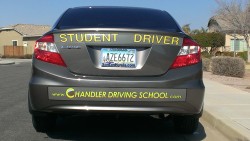Almost all rear-end collisions are avoidable if you maintain a safe distance between you and the cars around you. The consequences of such an accident could include increase in your insurance rates, responsibility for the expense of the damages, the time that this will take to get this handled, not to mention the aggravation.
All too often we see vehicles following too closely on our local roads. If cars maintain a safe following distance, however, the number of rear-end accidents would drop. It’s just a matter of keeping in mind 3 things: following distance, reaction time, and stopping distance. An appropriate following distance allows for a good reaction time, which makes for safer stopping distance.
A good way to calculate following distance is to find a fixed object on the road ahead or an overpass on a highway, then when the back tires of the car ahead of you clear it, you count 3 seconds, by then you should be crossing the same spot. Making sure there are 3 seconds between you and the car ahead should give you enough reaction time and stopping distance to respond to problems in the lane ahead of you. In inclement weather you’ll want to add a couple of seconds.
Reaction distance is the amount distance traveled from moment you notice you need to stop, to moving your foot to the brake. Traveling too closely, you will not allow you to apply the brake in a timely manner, consequently your stopping distance is shortened.
Stopping distance is the distance you needed to stop the car completely. No matter how good a driver you are, without enough room to stop, you’ll most likely make contact with the car ahead.
Maintaining a safe following distance also allows you to look ahead (instead of at the rear lights of the car in front). This enables you to pan and scan for possible hazards farther ahead. It also gives you the freedom to begin to brake sooner, communicating to the car behind you, thus, allowing them to prepare to stop from farther away. This will help you to not get hit from the back. The cushion created between you and the cars around you could be the difference between having a collision or not.


